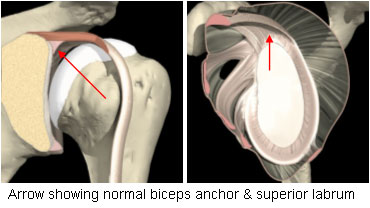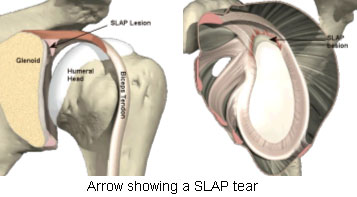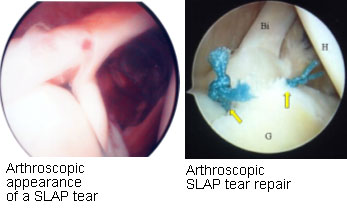What is meant by a SLAP tear?
The term ‘SLAP’ is an abbreviation which stands for “Superior Labrum from Anterior to Posterior”. It implies an avulsion tear (pulling off) of the biceps anchor (attachment of the biceps tendon) from the top of the glenoid socket along with the superior glenoid labrum. SLAP tears may be accompanied by tendinitis or a tear of the biceps tendon. SLAP tears are classified into various types depending upon whether there is just fraying of the biceps anchor or a frank avulsion of the biceps anchor or the tear extends into the biceps tendon, or there is disruption of the biceps tendon fraying, avulsion, tear or disruption of the biceps tendon.


How does a SLAP tear occur?
A SLAP tear can occur either due to a fall on an out-stretched hand, repetitive overhead action (as in a throwing athlete) or lifting of a heavy object. They frequently co-exist with dislocations or instability of shoulder.
How is SLAP tear diagnosed?
Typical symptoms of a SLAP tear include a catching or popping sensation in the shoulder and pain with shoulder movements, most often with overhead activities such as throwing. Patients will often complain of pain with a sense of instability in the shoulder. The pain is often felt as a deep-seated pain which is difficult to pin point.
A thorough physical examination may be helpful in arriving at a diagnosis. The O’Brien’s test and the Crank shaft test are some of the tests that may be positive in patients with a SLAP tear. However, none of these tests are very specific for a SLAP tear, and often it is not possible to diagnose a SLAP tear just on the basis of clinical examination, and further tests may be necessary. SLAP tears may also be associated with other pathology like shoulder instability or rotator cuff tears.
What tests are necessary to prove or confirm diagnosis?
1. Plain X-rays: These are usually normal in SLAP tears. X-rays may pin point reveal associated pathology like subacromial spurs or acromial-clavicular joint arthritis in cases associated with shoulder impingement or rotator cuff tears.
2. MRI scanning: This is the imaging modality of choice for diagnosing SLAP tears. MR arthrography (MR imaging done with an injection of contrast in the shoulder) enhances the chances of diagnosing SLAP tears.
In many patients it may not be possible to diagnose a SLAP tear with the above mentioned tests. These patients will need arthroscopic evaluation of the shoulder to ascertain the diagnosis of a SLAP tear.
Treatment of SLAP tears
This is divided into non-operative and operative treatment.
1) Non-operative treatment
All patients should be treated non-operatively initially. This consists of:
1. Rest to allow the lesion to heal
2. Physiotherapy
a. Modalities like SWD to relieve pain
b. Exercises to improve the range of motion of shoulder
c. Exercises to strengthen the shoulder
2) Surgical treatment
This is reserved for those patients who fail to respond to non-operative treatment. Arthroscopic surgery is the mainstay for diagnosing as well treating SLAP tears. The type of surgery required depends upon the type of SLAP tear. The surgical options include:
1. Arthroscopic debridement of the SLAP lesion
2. Arthroscopic repair (fixing back the avulsed superior labrum and the biceps anchor back to the glenoid)
3. Biceps tenodesis (re-attaching the biceps tendon to the upper end of the humerus). This is reserved for patients with frayed or torn biceps tendon. This can be done arthroscopic or open.

Post-operative rehabilitation after SLAP repair
After surgery the patient’s arm is rested in a sling for a period of 4 to 6 weeks depending upon the type of surgery performed and the strength of fixation of the biceps anchor. While in the sling the patient is put on pendulum exercises Pendulum exercises (gentle range of motion exercises) are started after 2-3 weeks. Shoulder strengthening exercises are started around 4 to 6 weeks’ time. Return to baseline activity may take up to 3 months. Return to sporting activity may take up to 4-6 months.
2) Surgical treatment